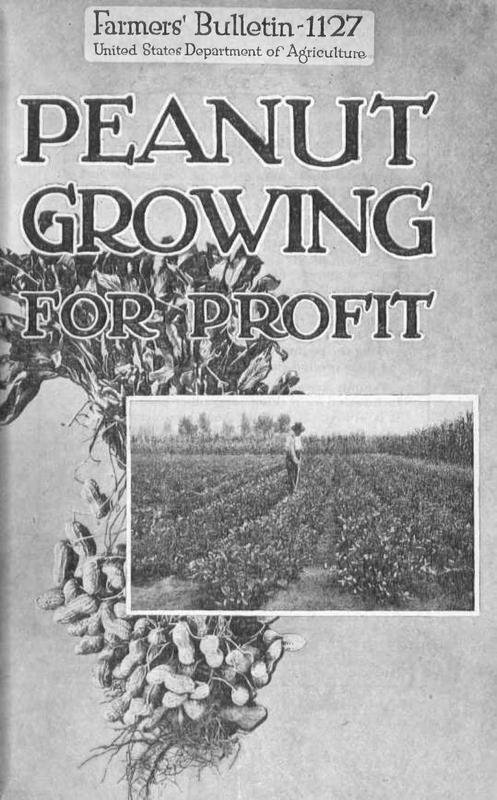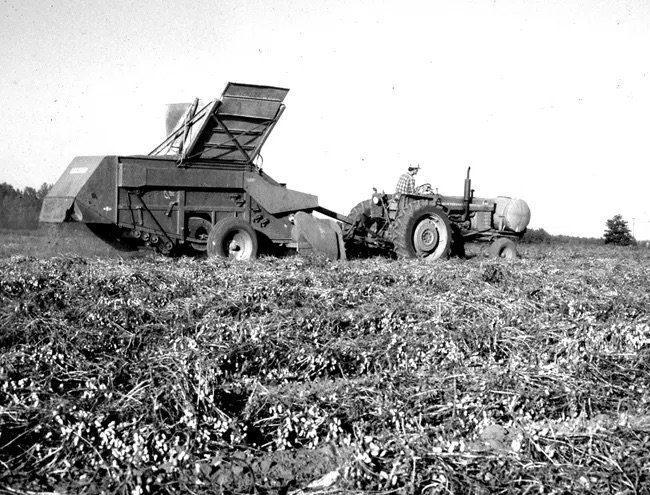
Peanuts 101
The Peanut (1911)
Source: USDA
Peanut Growing for Profit (1920)
Source: USDA
Early Peanut Crop Marker
Source: The Historical Marker Database
Photographed By Bernard Fisher
A tractor pulls a peanut harvester.
Source: National Park Service
Jimmy Carter standing in front of Carter's Peanut Warehouse.
Source: National Park Service
Peanut History
The peanut plant probably originated in Brazil or Peru, although no fossil records exist to prove this. For as long as people have been making pottery in South America (3,500 years or so) they have been making jars shaped like peanuts and decorated with peanuts. Graves of ancient Incas found along the dry western coast of South America often contain jars filled with peanuts and left with the dead to provide food in the afterlife. Tribes in central Brazil also ground peanuts with maize to make an intoxicating beverage for celebrations.
Peanuts were grown as far north as Mexico by the time the Spanish began their exploration of the New World. The explorers took peanuts back to Spain, where they are still grown. From Spain, traders and explorers took peanuts to Africa and Asia. In Africa the plant became common in the western tropical region. The peanut was regarded by many Africans as one of several plants possessing a soul.
When Africans were brought to North America as slaves, peanuts came with them. Slaves planted peanuts throughout the southern United States (the word goober comes from the Congo name for peanuts – nguba). In the 1700’s, peanuts, then called groundnuts or ground peas, were studied by botanists and regarded as an excellent food for pigs. Records show that peanuts were grown commercially in South Carolina around 1800 and used for oil, food and a substitute for cocoa. However, until 1900 peanuts were not extensively grown, partially because they were regarded as food for the poor, and because growing and harvesting were slow and difficult until labor-saving equipment was invented around the turn of the century.
The first notable increase in U.S. peanut consumption came in 1860 with the outbreak of the Civil War. Northern soldiers, as well as Southern, used the peanut as a food. During the last half of the 19th century, peanuts were eaten as a snack, sold freshly roasted by street vendors and at baseball games and circuses. While peanut production rose during this time, peanuts were harvested by hand which left stems and trash in the peanuts. Thus, poor quality and lack of uniformity kept down the demand for peanuts.
History of Peanuts in AmericaAround 1900, equipment was invented for planting, cultivating, harvesting and picking peanuts from the plants, and for shelling and cleaning the kernels. With these mechanical aids, peanuts rapidly came into demand for oil, roasted and salted nuts, peanut butter and candy. George Washington Carver began his research into peanuts in 1903 at Tuskeegee Institute. Research would lead him to discover improvements in horticulture and the development of more than 300 uses for peanuts (including shoe polish and shaving cream). The talented botanist recognized the value of the peanut as a cash crop and proposed that peanuts be planted as a rotation crop in the Southeast cotton-growing areas where the boll weevil insect threatened the regions’ agricultural base. Farmers listened and the face of southern farming was changed forever. For his work in promoting its cultivation and consumption, Carver is considered the father of the peanut industry.
Soon, mechanized machinery simplified peanut harvesting and processing. Peanut production rose rapidly during and after World Wars I and II as a result of the peanut’s popularity with Allied forces, and as a result of the post-war baby boom. Street vendors began selling roasted peanuts from carts, as did vendors at circuses and baseball stadiums.
Today, peanuts contribute over four billion dollars to the U.S. economy each year. Although the U.S. is a major exporter of edible peanuts to various countries around the world, they are grown in countries as far flung as China, Australia, Argentina and the Continent of Africa.
Peanut Types
Although peanuts come in many varieties, there are four basic market types: Runner, Virginia, Spanish and Valencia. Each of the peanut types is distinctive in size, flavor, and nutritional composition.
Within each four basic types of peanuts, there are several “varieties” for seed and production purposes. Each variety contains distinct characteristics which allows a producer to select the peanut that is best suited for its region and market.
Runner
Runners have become the dominant type due to the introduction in the early 1970’s of a new runner variety, the Florunner, which was responsible for a spectacular increase in peanut yields. Runners have rapidly gained wide acceptance because of the attractive, uniform kernel size. Fifty-four percent of the runners grown are used for peanut butter. Runners are grown mainly in Georgia, Alabama, Florida, Texas and Oklahoma.
Virginia
Virginias have the largest kernels and account for most of the peanuts roasted and processed in-the-shell. When shelled, many of the larger kernels are sold as gourmet snack peanuts. Virginias are grown mainly in southeastern Virginia, northeastern North Carolina and South Carolina.
Spanish
Spanish-type peanuts have smaller kernels covered with a reddish-brown skin. They are used predominantly in peanut candies, with significant quantities used for snack nuts and peanut butter. They have a higher oil content than the other types of peanuts which is advantageous when crushing for oil. They are primarily grown in Oklahoma and Texas.
Valencia
Valencias usually have three or more small kernels to a pod and are covered in a bright-red skin. They are very sweet peanuts and are usually roasted and sold in-the-shell. They are also excellent for fresh use as boiled peanuts. New Mexico is the primary producer of Valencia peanuts.
Peanut Plant Anatomy
The peanut is unusual because it flowers above the ground, but fruits below the ground. Typical misconceptions of how peanuts grow place them on trees (like walnuts or pecans) or growing as a part of a root, like potatoes.
Peanut seeds (kernels) grow into a green oval-leafed plant about 18 inches tall which develop delicate flowers around the lower portion of the plant. The flowers pollinate themselves and then lose their petals as the fertilized ovary begins to enlarge. The budding ovary or “peg” grows down away from the plant, forming a small stem, which extends to the soil. The Peanut embryo is in the tip of the peg, which penetrates the soil. The embryo turns horizontal to the soil surface and begins to mature taking the form of peanut. The plant continues to grow and flower, eventually producing some 40 or more mature pods. From planting to harvesting, the growing cycle takes about four to five months, depending on the type or variety. The peanut is a nitrogen-fixing plant; its roots form modules which absorb nitrogen from the air and provides enrichment and nutrition to the plant and soils.
Explain how parts are used (ex: hull used for animal feed) - Ashley has images she will make changes to and send
Simplified Peanut anatomy diagram
maybe add the diagram below to nutrition section with blurb about percentages
Where & How Peanuts Grow
See “NC Peanuts from Farm to Market PDF”
Lorem ipsum dolor sit amet, consectetur adipiscing elit. Vivamus malesuada elementum mi a malesuada. Ut aliquet efficitur arcu, et tempor arcu venenatis ac. Quisque fermentum, diam vitae dictum tempus, metus ligula gravida lacus, id elementum ante massa at tellus. Pellentesque eget porttitor ante. Class aptent taciti sociosqu ad litora torquent per conubia nostra, per inceptos himenaeos. Quisque sagittis laoreet justo, ut pellentesque felis. Fusce finibus dolor ex, eu lobortis leo aliquet ornare. Fusce at neque sit amet sem cursus lobortis. Etiam vitae elementum eros. Phasellus ultricies risus dolor, id rutrum odio sagittis et. Mauris augue orci, hendrerit eu interdum at, mollis eu leo. Suspendisse pharetra leo nec risus iaculis, ac vehicula eros finibus. Morbi consectetur vestibulum eros, quis tincidunt tellus. Praesent lectus neque, mollis sit amet mollis ut.
Integer lacinia nulla eu lectus tristique, eget euismod ligula varius. Aenean lacinia odio in lorem mattis lacinia. Nunc in felis tellus. Phasellus ac quam id tortor lobortis lacinia suscipit ut nunc. Ut scelerisque metus finibus velit fermentum, quis pulvinar nisi accumsan. Maecenas posuere luctus dui eget mattis. Morbi suscipit ipsum sit amet nibh iaculis, non pellentesque mi iaculis. Praesent volutpat mi lorem. Pellentesque feugiat tempor felis, at tincidunt elit ullamcorper at. Curabitur tristique ornare velit, in dapibus ipsum dictum at etiam semper.
Where do peanuts grown in the United States?
Lorem ipsum dolor sit amet, consectetur adipiscing elit. Vivamus malesuada elementum mi a malesuada. Ut aliquet efficitur arcu, et tempor arcu venenatis ac. Quisque fermentum, diam vitae dictum tempus, metus ligula gravida lacus.
Lorem ipsum dolor sit amet, consectetur adipiscing elit. Vivamus malesuada elementum mi a malesuada. Ut aliquet efficitur arcu, et tempor arcu venenatis ac. Quisque fermentum, diam vitae dictum tempus, metus ligula gravida lacus, id elementum ante massa at tellus. Pellentesque eget porttitor ante. Class aptent taciti sociosqu ad litora torquent per conubia nostra, per inceptos himenaeos. Quisque sagittis laoreet justo, ut pellentesque felis. Fusce finibus dolor ex, eu lobortis leo aliquet ornare. Fusce at neque sit amet sem cursus lobortis. Etiam vitae elementum eros. Phasellus ultricies risus dolor, id rutrum odio sagittis.













